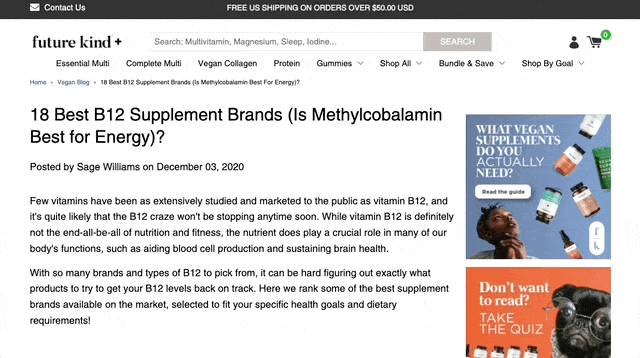Content marketing is one of the most successful strategies to boost organic traffic, conversions, and sales. But to be effective in 2022, it needs to stand out from the crowd. Especially if you’re after a high ROI and low production costs.
Fortunately, some tricks can help brands create content that delivers results. One of them is to focus on quality above all else. Another is to consistently keep an eye on market trends and consumer sentiment and invest in pieces that are likely to resonate with your audience. But, there’s also a third tactic: investing in visual content marketing.
According to Venngage, as much as 48.2 percent of all marketing content published in 2020 contained visuals. And the most successful of these included original graphics, videos, and data visualizations.
So, considering that visuals do an excellent job at helping brands achieve results, you’re probably wondering: what types of visual content does your content marketing strategy need in 2022?
Let’s find out.
Source: depositphotos.com
1. Photos
A content marketing strategy that doesn’t include photos is almost unimaginable. You have to rely on images even if social media does not make your list of preferred distribution channels and you only publish content on your blog.
Research by Orbitmedia shows that the number of visuals included in blog posts correlates to their success.
Source: orbitmedia.com
This is why brands like Future Kind make sure to break up chunks of text with visuals. This simple tactic enables them to create informative and visually engaging buying guides like they did on their best B12 supplements guide.
Source: futurekind.com
Of course, the quality and originality of the photos you use are both vital factors. The same Venngage survey from above found that stock images didn’t drive results in 40.8 percent of cases, which is a strong indicator that simpler but original photos make the basis of a successful visual content marketing strategy.
2. Video
According to the Content Marketing Institute’s Insights for 2022, 66 percent of B2B marketers used video in the last 12 months. And, according to this same resource, video was the most effective visually-based type of content published in 2021.
With this in mind, you’ll want to look for ways to include more of it in your content marketing strategy for 2022.
Great ideas for using videos to boost brand awareness, conversions, and sales include webinars, interviews with industry experts, and how-tos, like the ones created by Moz.
3. Illustrations
When neither photos or videos work for your business, go with illustrations.
Seeing how they rely on visual simplicity to depict complicated concepts, illustrations are perhaps the most suitable type of visuals when discussing entire product categories. For a great example, take a look at how MedicalAlertBuyersGuide did it on their medical alert buyers guide page.
Source: medicalalertbuyersguide.org
Likewise, illustrations work great when trying to explain processes, as SaaS brands often have to do.
4. Visual CTAs
The fourth visual must-have for 2022 is a series of well-designed calls to action for your website.
Most business owners only think about CTAs in terms of buttons—which are, admittedly, crucial in securing high conversion rates. Unfortunately, however, they forget that the best way to draw web visitors’ attention is with a visual. This is why surrounding high-value webpage elements with images is such a great strategy.
For example, Rain or Shine Golf uses an image instead of a traditional footer section as shown on their best golf simulators page, knowing that the photo is more likely to drive interest than a block of color. Then, it places conversion-driving information—including points of contact and a newsletter sign-up form in the center of the image – knowing that it’s bound to get attention.
Source: rainorshinegolf.com
This is a great strategy to copy in 2022, mainly because it’s easy to reproduce and promises stellar results. Plus, you can apply it in any website section, including even the main header.
5. Data visualizations
The importance of trustworthy and accessible information is becoming bigger than ever. And it’s only going to grow.
This is primarily due to the sheer volume of data created, which is predicted to triple between 2020 and 2025. But, it also has to do with shifting consumer sentiments, with fewer people trusting authorities like governments and more of them putting their confidence in businesses. Altogether, that’s why visual representations of verified data will become more and more impactful, especially when convincing consumers to convert.
The B2B sector already understands this. The fifth most common content asset marketers created in 2021 included infographics, charts, and data visualizations.
Source: contentmarketinginstitute.com
6. Screenshots
For a slightly less data-driven approach to visuals in 2022, follow the age-old advice of “show, don’t tell.”
Brands whose marketing strategies rest on education (and conversion rate data shows that this is an excellent approach for goal-oriented brands), can rely on screenshots to improve otherwise plain instructional methods.
For example, Scott’s Cheap Flights uses screenshots to guide its readers through the process of using different flight booking software. The brand knows that this is the most actionable, concrete way to help users understand the procedure.
Source: scottscheapflights.com
Or, for a slightly more conversion-oriented illustration, Asana uses in-app screenshots to offer previews of its project management software. This is an important tactic because people are much more likely to commit to a purchase if they get to see the product in action before buying.
Source: asana.com
7. User-generated content
For those whose goal for 2022 includes building stronger bonds with their clients and getting people to engage with their brand, UGC is the absolute go-to in terms of visuals.
As a type of visual content that provides social proof, builds trust, manages buyer expectations, and encourages brand loyalty, UGC is one of the most effective ways to use visuals in content marketing. And, best of all, it doesn’t have to cost a thing.
Of course, if your strategy is to collaborate with influencers, you might have to cover some costs for acquiring UGC. But, if you go the route of Chobani, it’s enough to just encourage your clients to upload photos and videos of them using your products for a chance to be featured on your site and social media profiles.
Source: instagram.com
8. Augmented reality
Last but not least, if you’re 100% committed to entering 2022 with a fresh approach to content, you might want to start playing around with new tech.
According to Statista, the AR, VR (virtual reality), and MR (mixed reality) market will reach $300 billion by 2024. In other words, this type of content will be everywhere. If you want to capitalize on the trend, you better start thinking about it before it’s too late.
Big names like Ikea have been including AR in their content marketing strategies for the past five years. But, one brand that stands out is MAC Cosmetics, with its virtual try-on, which is available both on its website and on its social media profiles.
Source: instagram.com
Final thoughts
People are visual creatures, so investing in visuals makes for an excellent tactic to achieve success with content.
The formats we’ve covered here are all excellent starting places for 2022. However, marketers will have to decide for themselves whether a particular type of visuals offers the perks they’re looking for. After all, great content can be expensive to create.
So it’s essential to consider both the potential ROI and the production costs before committing to a single format. That way, you’ll have the absolute highest chances of making marketing decisions guaranteed to lead to success.

















